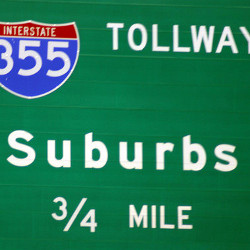 One of the hottest debates today among urbanists and economic geographers is the extent to which population growth and development are shifting from the periphery of U.S. metropolitan areas back to their urban cores. The latest contribution to this discussion, “Even after the Housing Bust, Americans Still Love the Suburbs,” by Jed Kolko in the New Geography blog, concedes that “urban” areas are growing but insists “suburban” areas are growing faster.
One of the hottest debates today among urbanists and economic geographers is the extent to which population growth and development are shifting from the periphery of U.S. metropolitan areas back to their urban cores. The latest contribution to this discussion, “Even after the Housing Bust, Americans Still Love the Suburbs,” by Jed Kolko in the New Geography blog, concedes that “urban” areas are growing but insists “suburban” areas are growing faster.
His conclusion: “America’s suburban areas are continuing to grow faster than America’s urban areas. Despite falling homeownership, rising gas prices, downsizing baby boomers and improvements to city living, American suburbanization hasn’t reversed. Even though the highest-density neighborhoods, particularly in the largest metros, have grown in the past year, the suburbanization of America marches on.”
Before we go any further, let’s clear up what Kolko means by “urban” and “suburban.” He breaks down population trends by zip code. Calculating the population density of each zip code (number of residents per square mile), he defines “urban” zip codes as those with higher densities and “suburban” as those with lower densities, regardless of where they may be located within the metropolitan area. He calculates growth by measuring the number of households moving in and out of each zip code between 2011 and 2012, according to U.S. Postal Service data.
In a handful of metropolitan regions — Memphis, New York, Chicago, San Jose and Pittsburgh, urban growth outpaced suburban growth. But in others — San Antonio, Oklahoma City, Houston, Austin and Detroit — growth was concentrated heavily in the suburbs. Here are the growth percentages for Virginia’s largest metropolitan areas:

Clearly, Kotko’s analysis describes Hampton Roads, where urban zip codes actually lost a little population. And it holds true, but to a far lesser degree, in the Washington and Richmond MSAs. Indeed, the data shows that Richmond’s “urban” zip codes gained nearly as much population as its “suburban” zip codes, which comes as quite a surprise because Richmond had long been the poster child for suburban sprawl in Virginia.
Kotko presents a fresh way of looking at metropolitan population trends and his main point seems incontestable. Low-density areas of U.S. metros are still growing faster than high-density areas. But what does that tell us? Not all that much.
What’s missing is context. Let us imagine what the numbers would have shown 30 years ago when central cities were experiencing white flight and disgorging their populations into the suburbs. Clearly, that trend has spent itself, except in special basket cases like Detroit. One could surmise from Kotko’s data that central cities are growing in population again. By emphasizing that suburban growth still outpaces urban growth, Kotko overlooks the remarkable fact that urban areas are growing as vigorously as they are!
There’s another big limitation to Kotko’s analysis. He defines urban and suburban areas by population density but he does not tell us where in the metropolitan area those zip codes are located. Are the high-density zips located mainly in inner cities or near the urban core? Or are they scattered about the metropolitan region? We cannot tell what’s really happening on a metro-by-metro basis unless we know.
Finally and most importantly, this analysis overlooks what the “back to the city” proponents are really saying. In his book, “The Great Inversion and the Future of the American City,” Alan Ehrenhalt doesn’t contend that cities are growing faster than suburbs, he says that an inversion is taking place: Affluent segments of the population are moving back to the urban core, in the European mode, while poorer elements are moving to the suburbs. (Christopher Leinberger, also quoted in this blog, makes much the same argument.)
Ehrenhalt’s thesis describes what I see happening in Virginia, particularly in the Richmond region. And it is consistent with the findings of University of Virginia urban planning scholar William Lucy, whose research began documenting the shift nearly two decades ago in his dissection of 1990s census figures.
My point is not that the “suburbs” are dead. It’s that U.S. metropolitan areas have reached an inflection point. Growth and development are shifting back toward the urban core, although that trend can encompass the revitalization and densification of areas within “suburban” counties. The dramatic make-over of Tysons Corner (oops, I think they’re just calling it Tysons now) is a case in point.
An increasing share of the population is looking for walkable, mixed use communities, preferably with access to mass transit. The key point for legislators and policy makers in Virginia is to recognize that infrastructure investment needs to reflect that shift in personal preferences. To date, it has not.

Email this author
- The Most Progressive Budget in Virginia’s History - December 21, 2019
- When is a Clean Water Act Permit Needed? - December 21, 2019
- Should U.S. Consider Modern Monetary Theory to Improve Economy? - December 21, 2019
